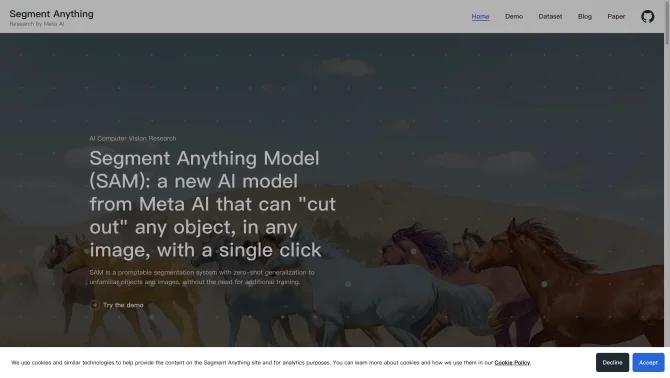Introduction
Segment Anything, developed by Meta AI, is a state-of-the-art AI tool that enables users to segment any object in an image with a single click. It is designed to work with a variety of input prompts, allowing for a wide range of segmentation tasks without the need for additional training. The model is trained on an extensive dataset of 11 million images and 1.1 billion masks, showcasing strong zero-shot performance across various tasks. With its user-friendly interface and robust features, Segment Anything is a powerful tool for both researchers and industry professionals.
background
Meta AI's FAIR lab has been at the forefront of AI research, developing influential models and tools that have shaped the AI landscape. The Segment Anything Model (SAM) represents a significant advancement in image segmentation, leveraging the power of foundation models to generalize across tasks without specific training. The development of SAM was inspired by the success of models like BERT and GPT in NLP, aiming to bring similar versatility to computer vision.
Features of Segment Anything
Zero-Shot Inference
SAM can segment images of unfamiliar objects without prior training, thanks to its foundation model approach.
Promptable Segmentation System
Users can provide input prompts specifying what to segment, enabling a wide range of tasks.
High-Quality Masks
SAM is trained to produce high-quality object masks, suitable for detailed analysis.
Extensive Training Data
SAM's training on 11 million images and 1.1 billion masks ensures robust performance.
Custom Mask Generation
Users can generate custom masks for all objects in an image, tailored to specific needs.
Automated and Interactive Annotation
SAM supports both automated segmentation and interactive annotation for microscopy and other bio-imaging data.
How to use Segment Anything?
To get started with Segment Anything, first install the required dependencies and the model itself using pip or by cloning the repository. Download a model checkpoint and initialize the model with the checkpoint path. Use the SamPredictor or SamAutomaticMaskGenerator to set an image and generate masks based on input prompts.
FAQ about Segment Anything
- How do I install Segment Anything?
- Use pip to install Segment Anything from the GitHub repository or clone it and install locally.
- What are the system requirements?
- Python 3.8 or higher, along with PyTorch and TorchVision.
- How do I use Segment Anything for my images?
- Initialize the model with a checkpoint, set the image, and generate masks using the provided prompts.
- Can I use Segment Anything for medical images?
- Yes, SAM has been adapted for medical image segmentation tasks.
- What is the licensing for Segment Anything?
- It is licensed under the Apache 2.0 license.
Usage Scenarios of Segment Anything
Academic Research
Use SAM for object detection and segmentation in biological and medical imaging studies.
Market Analysis
Leverage SAM for analyzing consumer behavior through image segmentation in market research.
Automated Image Annotation
Apply SAM to streamline the process of image annotation in large datasets.
Facial Recognition Systems
Utilize SAM for accurate facial feature extraction in security and identity verification applications.
User Feedback
Users have praised SAM for its ease of use and powerful segmentation capabilities.
Researchers in the field of computer vision have found SAM to be a valuable tool for their studies, highlighting its zero-shot inference capabilities.
Professionals in the industry have reported significant time savings and improved efficiency when using SAM for image analysis tasks.
The GitHub community has actively contributed to the development of SAM, suggesting its popularity and utility among developers.
others
Segment Anything has been integrated into various projects and workflows, demonstrating its versatility and effectiveness in practical applications. It has become a cornerstone for tasks requiring high-precision image segmentation.
Useful Links
Below are the product-related links of Segment Anything, I hope they are helpful to you.
